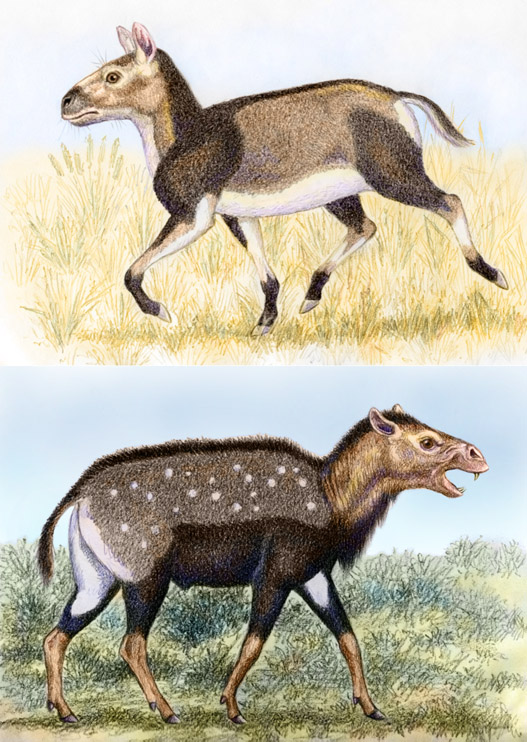ShopDreamUp AI ArtDreamUp
Deviation Actions
Description
These two animals were Litopterns, a South American group of ungulate-like animals. They appear to be only very distantly related to the surviving modern ungulates. They evolved in isolation in South America, experiencing their heyday in the Miocene but dwindling later. The final nail in the coffin appears to have been the formation of the land bridge between North and South America, which allowed 'modern' ungulates like deer, peccaries, tapirs, camels and horses entered to enter, with which the native South American ungulates could not compete - but a couple of species of litoptern did survive until quite recently.
Thoatherium (top) and Diadiaphorus (bottom) belonged to the Proterotheriidae. Diadiaphorus was somewhat like a medium-sized antelope, reaching a head-body length of 1.2 m. It had a single horse-like hoof that was in contact with the ground, but two smaller hooves higher up on each leg. It also had tusk-like upper incisors. Thoatherium was smaller, with a head-body length of 70 cm, but was very specialized in having just a single hoof per foot, like a horse ... in fact even more specialized than horses in that the 'splint bones' that remain as remnants of the outer toes of horses, have also been lost in Thoatherium. Bear in mind that this animal was not a horse precursor, but a completely different lineage. The teeth of Thoatherium and Diadiaphorus indicate that they were leaf browsers rather than grazers, but both must have been fast runners. In this reconstruction I give them fairly bold markings. Most living mammals have distinct coat colours and patterns, but of course extinct species would have been unique, not having exact copies of the markings of living species, so in recreating these two I tried to be inspired by living antelopes and gazelles but still make them different from any living ones. Both these species lived in the Miocene, about 15 million years ago. The last litopterns died out at the end of the Pleistocene, 10 000-20 000 years ago.
Thoatherium (top) and Diadiaphorus (bottom) belonged to the Proterotheriidae. Diadiaphorus was somewhat like a medium-sized antelope, reaching a head-body length of 1.2 m. It had a single horse-like hoof that was in contact with the ground, but two smaller hooves higher up on each leg. It also had tusk-like upper incisors. Thoatherium was smaller, with a head-body length of 70 cm, but was very specialized in having just a single hoof per foot, like a horse ... in fact even more specialized than horses in that the 'splint bones' that remain as remnants of the outer toes of horses, have also been lost in Thoatherium. Bear in mind that this animal was not a horse precursor, but a completely different lineage. The teeth of Thoatherium and Diadiaphorus indicate that they were leaf browsers rather than grazers, but both must have been fast runners. In this reconstruction I give them fairly bold markings. Most living mammals have distinct coat colours and patterns, but of course extinct species would have been unique, not having exact copies of the markings of living species, so in recreating these two I tried to be inspired by living antelopes and gazelles but still make them different from any living ones. Both these species lived in the Miocene, about 15 million years ago. The last litopterns died out at the end of the Pleistocene, 10 000-20 000 years ago.
Image size
527x742px 183.13 KB
© 2014 - 2024 WillemSvdMerwe
Comments30
Join the community to add your comment. Already a deviant? Log In
So how DID hoofed placentals end up in South America before Panama?



































